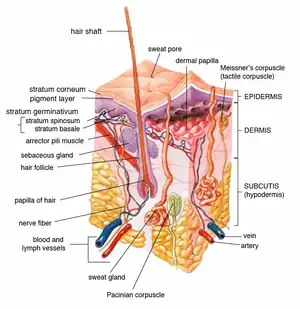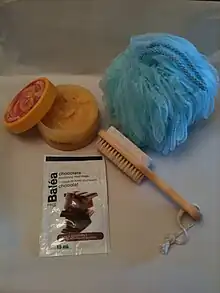Exfoliation (cosmetology)

Exfoliation involves the removal of the oldest dead skin cells from the skin's surface. The word comes from the Latin word exfoliare (to strip off leaves).[1] Exfoliation is involved in all facials and can be achieved by mechanical or chemical means, such as microdermabrasion or chemical peels.[2] Exfoliants are often advertised as treatments that promote beauty, youthful appearance, or health.[3][4]
History
The ancient Egyptians were the first to practice exfoliation.[5][6] Exfoliation was also used in Asia, specifically in China, during the Qing Dynasty (1644–1944).[7] In the Middle Ages, wine was used as a chemical exfoliant, with tartaric acid as the active agent.[6]
Types of exfoliation
Mechanical

Mechanical processes involve physically scrubbing the skin with an abrasive material.[8] Mechanical exfoliants include microfiber cloths, adhesive exfoliation sheets, micro-bead facial scrubs, crêpe paper, crushed apricot kernel or almond shells, sugar or salt crystals, pumice, and abrasive materials such as sponges, loofahs, brushes, and fingernails.[3][9] Facial scrubs are available in over-the-counter products for application by the user. People with dry skin should avoid exfoliants which have a significant portion of pumice, or crushed volcanic rock. Pumice is known as a material to exfoliate the skin of the feet.
Aside from microdermabrasion, derma-planing is a mechanical method of exfoliation that exfoliates the skin (or epidermis) by removing dead skin and vellus hair. The procedure is performed by an aesthetician, who gently glides a scalpel across the skin to remove the outermost layer of skin cells and hair from the face. As a by-product, it also shaves off the vellus hair, but the hair grows back at the same rate and texture as before.[10] The procedure involves the use of a 25 cm (10 in) scalpel which curves into a sharp point. In most cases, the blade is used on clean, dry skin on the forehead, cheeks, chin, nose, and neck. Derma-planing can also be performed on skin that has had oil applied to it.
Chemical
Chemical exfoliation, also known as chemical peeling, removes dead skin cells from the face with chemical substances.[11] Chemical exfoliants include scrubs containing salicylic acid, glycolic acid, fruit enzymes, citric acid, or malic acid, which may be applied in high concentrations by a medical professional, or in lower concentrations in over-the-counter products. Chemical exfoliation may involve the use of products that contain alpha-hydroxy acids (AHAs, like glycolic acid, lactic acid, mandelic acid, malic acid, tartaric acid, and citric acid), beta hydroxy acids (BHAs, typically salicylic acid), polyhydroxy acids (PHAs, like lactobionic acid, gluconolactone, and galactose) or enzymes (such as trypsin or collagenase) that weakens cell adhesion, allowing them to ease away. This type of exfoliation is recommended for people treating acne.[12][13] In Continental European beauty spa treatments, wine-producing grapes are considered to have exfoliating properties and are used in the practice of vinotherapy. Out of these, only AHAs and BHAs are available on the market for daily use. While AHAs are applied to clear the outer layer of the skin, BHAs penetrate and clean it from within.[14]
Some methods of hair removal also exfoliate the skin.
- Waxing is a mechanical process to pluck the hair out of the skin, but it also functions as a mechanical exfoliant. It can be done every two to eight weeks. It is not carried out as frequently as many exfoliants. Thus, it does not fully substitute for an exfoliation regimen.
- Chemical depilatory containing calcium hydroxide and/or thioglycolic acid, such as Nair, and shaving powder, are examples of a chemical hair removal product that also functions as a chemical exfoliant. They are applied more frequently than waxing (once a week rather than once a month) since they only partially destroy the hair below the skin, rather than pulling up the entire root as waxing does. Using them weekly can substitute for a weekly exfoliant regime.
- Wet shaving also has mechanical exfoliating properties. Moving a shaving brush vigorously across the face washes the face and removes dead skin at the same time. After applying the lather with a brush, the use of a razor removes dead skin because the razor is dragged closely across the skin, and exfoliates more effectively than an electric razor.
Disadvantages
According to dermatologists, chemical or manual exfoliation is not medically necessary, as dead skin cells already exfoliate naturally,[13] and excessive artificial exfoliation can break the skin's barrier against microorganisms and lead to infection,[13] as well as tightness and sensitivity in the skin.[13] Artificial exfoliation can exacerbate dry, flaky skin, which needs moisturization for repair,[13] and can result in some initial redness to the skin. Near the end of chemical peels, the skin frosts, with colors varying from a bright white to grey on the skin surface.[6]
Marine environmental impact of microbeads
Microbead particles used in mechanical exfoliation are too small (less than 1 mm) to be caught by sewage works, so large amounts of microbeads are released into the environment, which damage marine ecosystems.[15] Consequently, in June 2014, Illinois became the first American state to ban the use of microbeads, and cosmetics manufacturers such as L'Oreal, Johnson & Johnson, and Colgate agreed to use more natural ingredients.[15]
See also
- Chemical peel
- Debridement
- Exfoliating towel
- Medical spa
- Microdermabrasion
References
- ↑ "Exfoliation - Definition and More from the Free Merriam-Webster Dictionary". Merriam-webster.com. Retrieved 2 December 2014.
- ↑ "New Skin - Via Exfoliation". Reuters. Archived from the original on 6 March 2008. Retrieved 2 December 2014.
- 1 2 Alex Muniz. "Exfoliation - AskMen". AskMen. Retrieved 2 December 2014.
- ↑ "Natural Exfoliants for Your Body, Face, Lips: Which Ones Work Best?". Healthline. 29 October 2019. Retrieved 20 August 2021.
- ↑ https://hbmag.com/exfoliation/
- 1 2 3 "Medscape: Medscape Access". Emedicine.com. Retrieved 2 December 2014.
- ↑ "Culture Insider: Skincare in ancient China[1]- Chinadaily.com.cn". www.chinadaily.com.cn. Retrieved 1 March 2021.
- ↑ Anitra Brown. "What Is Exfoliation?". About. Retrieved 2 December 2014.
- ↑ Cathy Wong, ND. "How to Use a Dry Brush for Skin". About. Retrieved 2 December 2014.
- ↑ https://livingcitiesforum.org/tega-brain
- ↑ Soleymani, Teo; Lanoue, Julien; Rahman, Zakia (August 2018). "A Practical Approach to Chemical Peels". The Journal of Clinical and Aesthetic Dermatology. 11 (8): 21–28. ISSN 1941-2789. PMC 6122508. PMID 30214663.
- ↑ "Beauty & Skin: Facial Skin Exfoliation". Wdxcyber.com. Retrieved 2 December 2014.
- 1 2 3 4 5 "Exfoliating isn't necessary. But if you do it, follow the tips from these dermatologists". The Washington Post. 11 April 2021.
- ↑ "AHA vs. BHA: Choosing an Exfoliant, Acid Types, Products". Healthline. 15 March 2018. Retrieved 26 June 2021.
- 1 2 Hitchings, Lauren (23 June 2014). "Why Illinois has banned exfoliating face washes". New Scientist. Retrieved 24 June 2014.